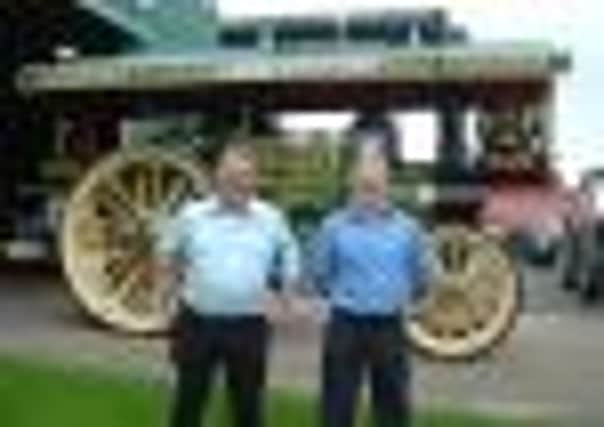Heavy metal monsters roll in to quiet Helmsley for the weekend


In 1962 a film called The Iron Maiden steamrollered its way into the hearts of millions. The star was a traction engine built in Leeds in 1920 by John Fowler and Co. Today it is owned by one of the committee members of the Yorkshire Traction Engine Club formed two years after the film came out.
The owner, Graeme Atkinson of Lebberston, hopes to have it on display at the club’s annual rally at Duncombe Park, Helmsley.
Advertisement
Hide AdAdvertisement
Hide AdThe Hunslet area of Leeds was a centre for the industry at the turn of the 20th century. Famous names included J & H McLaren & Co, Thomas Green & Son and Mann’s Patent Steam Cart and Wagon Co. Fowlers employed over 1,500 people at the peak of their production in the 1880s.
Mick Gaines-Burrill, the chairman of the club, is presently restoring a 1908 McLaren that spent most of its working life in New Zealand. His love affair with steam engines started when his grandparents took him to his first rally in Pickering as a five year- old in 1953. That rally, organised by the then Pickering Traction Engine Club, spawned the present club.
“Traction engines were already in the past by the time I saw them in 1953,” says Mick. “Their hey-day was between 1900 and 1918 when tractors superseded them.
“But the Second World War gave them a last hurrah. There was a shortage of petrol and diesel fuel for transport but plenty of coal.
Advertisement
Hide AdAdvertisement
Hide Ad“Steam engine manufacturers in Leeds and all around the UK had the market sewn up. They were the days when a great deal of trade was done through the colonies and the vast proportion of engines went abroad.
“At that time we were the manufacturing base for the world. The reason why so many are still around today – and why there will be 50 on show next weekend – is that they were so well built. They were the days when machines were built to last rather than today’s throwaway generation.”
One of the star attractions in the show will be Lightning II dating from 1913. It holds a special place in the Preston family’s hearts as it was the machine that brought about the birth of their renowned haulage business near Stokesley – better known today by the millions of motorists who pass their trucks daily on the main routes up and down the country as Preston’s of Potto. David Preston, the managing director, is to drive Lightning II to the show next weekend with his sons James and Jake. It will travel at an average speed of 10mph from Stokesley to Helmsely, via Chopgate. That’s rather slower than the motorcyclists for whom this is the route of choice to test their machines’ capabilities and their own riding skills. The Bilsdale TT is what locals calls it.
“We might get up to 20mph on a gentle slope, but you have to be very careful going downhill. It should take about five hours to get there,” says David.
Advertisement
Hide AdAdvertisement
Hide AdConflicts have generally been good news for these ancient behemoths. The next one after 1945, Suez, also put them in demand again.
“My grandfather had used steam engines as an agricultural contractor, but that market started to shrink as farmers bought their own tractors,” adds David.
“When the Suez crisis occurred in 1956 there was suddenly no diesel fuel for lorries. A local brick manufacturer couldn’t get his loads delivered. He saw Lightning II which my grandfather had bought for preservation and entered into a contract with him to haul the bricks as coal was still available.
“Lightning II was the last engine of its type to hold a licence for commercial road haulage in the UK. That contract brought about the business which we still run as a family concern today.
Advertisement
Hide AdAdvertisement
Hide Ad“It also brought about romance. My mother and father, Richard and Anne, first met by the front wheel at Stokesley Fair.”
Richard Preston has been a stalwart of the club for many years and became president earlier this year. The family has a massive collection of steam engines as well as a tremendous Gavioli steam organ which replicates the sound of an orchestra.
Steamrollers had a longer working life than their cousins and some fine examples will also will also be on display at Duncombe Park. They were still in use in the 1960s.
“Years ago you could have a steam rally and fill a field full of steam engines,” says Chris. “The crowds would flock in their tens of thousands. That’s not quite the case today.
Advertisement
Hide AdAdvertisement
Hide Ad“We put on a great show, with hundreds of machines of all kinds from traction engines, steamrollers and tractors to vintage lorries, cars and motorcycles, but it’s different. There are not the same number of the older generations who were familiar with traction engines, for obvious reasons, and we now attract many more families.
“The dads want to come to see the engines and old cars and lorries. But the ladies need some retail therapy so we have plenty to offer them and the children.
“We are still very much committed to traction engines and preserving the memories of those days.”
Getting all steamed up
The origins of the club date back a group of traction engine enthusiasts racing four of them around a field – Black Bess, Old Glory, Surprise and Mary. Surprise is still a regular at the rally.
Advertisement
Hide AdAdvertisement
Hide AdThe annual rally started in Pickering, moved to Castle Howard and Driffield and settled at Duncombe Park where it has remained since 1990.
The Great Yorkshire Traction Engine Club Rally, Saturday July 7 and Sunday July 8.